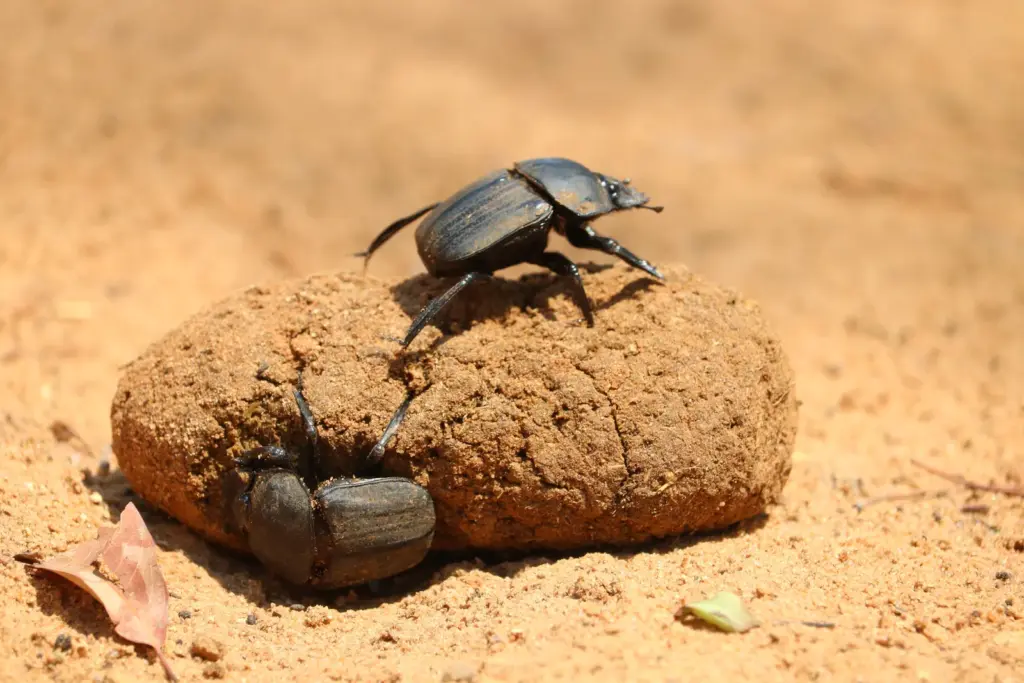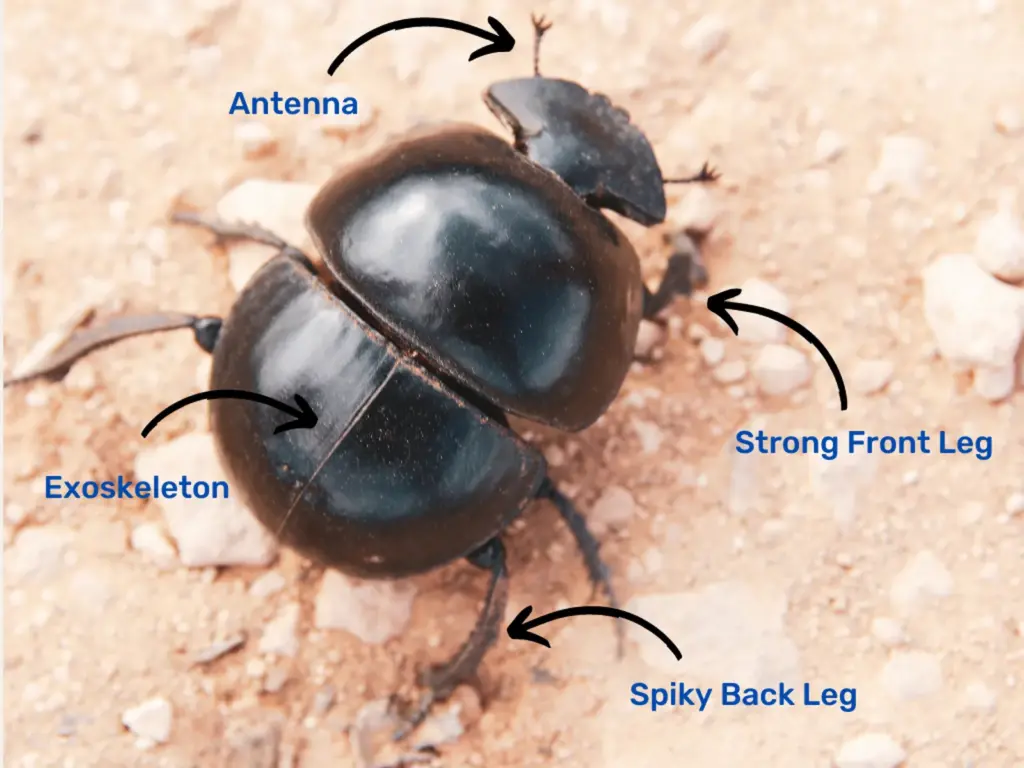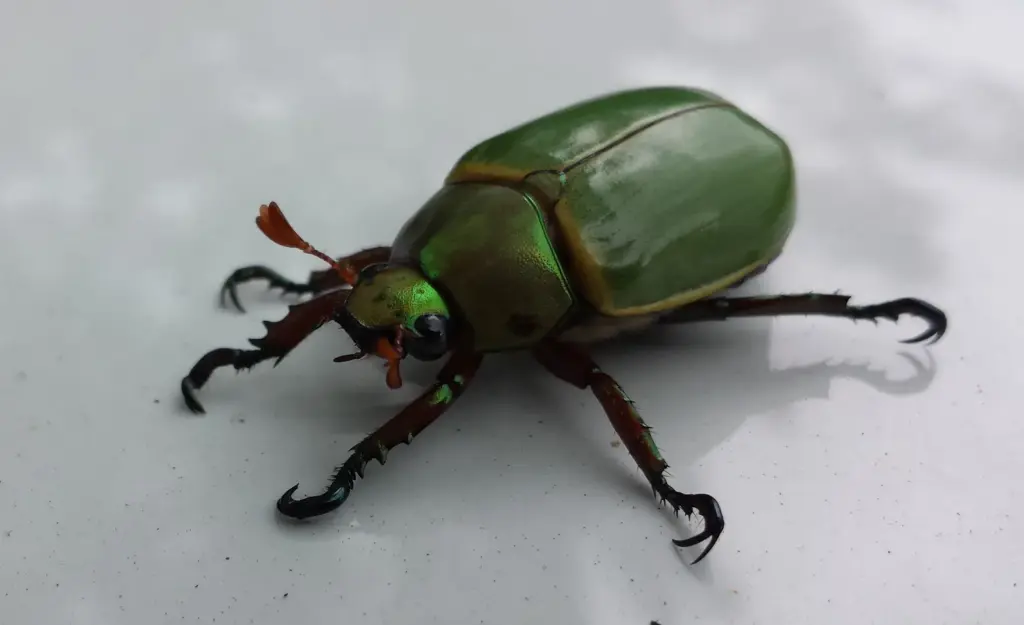Dung beetles are members of the family Scarabaeidae and are associated with their fun behaviour of rolling balls of faeces and even fighting over this animal product that, for them, is precious for living. Dung is indeed the primary resource for these beetles. They use it for food and reproduction purposes.
However, dung beetles are also important in maintaining ecological balance within many ecosystems. They can be an important component in soil nutrient cycling, soil health, and even controlling harmful parasites. They emerge as unsung heroes in agriculture, safeguarding livestock health and preserving pasture fertility.
Like many other creatures on our planet, dung beetles face many threats, from habitat destruction to the impacts of climate change.
This article explores the world of dung beetles, looking at their dietary habits, anatomic characteristics, reproductive behaviour, and positioning within different worldwide ecosystems.
Main Takeaways
- Ecological Importance: Dung beetles are important in nutrient recycling, soil aeration, and parasite control, with benefits for ecosystems and agriculture.
- Diverse Behaviors: They have various dung-handling strategies, including rolling, tunnelling, and dwelling, showing how they can be adaptable.
- Global Distribution: Found on every continent except Antarctica, dung beetles can live in different environments, from rainforests to savannas and deserts.
- Agricultural Benefits: Dung beetles support sustainable farming systems. They reduce livestock parasites and improve soil fertility.
- Threats to Survival: Habitat destruction, pesticides, climate change, and competition from invasive species endanger dung beetle populations.
- Conservation Importance: Protecting dung beetles is essential for maintaining ecological balance, healthy soils, and thriving biodiversity.

Scientific Classification of Dung Beetles
Dung beetles are members of the order Coleoptera and have a very complex taxonomy and species diversity within their classification.
They are mainly classified under the superfamily Scarabaeoidea; these insects are primarily recognized for their symbiotic relationship with dung, which serves as both a food source and a substrate for reproduction.
Within this superfamily, the family Scarabaeidae is particularly significant, as it houses the subfamily Scarabaeinae, commonly known as “true dung beetles.” This subfamily alone comprises over 5,000 distinct dung beetle species that have evolved specifically to consume and utilize faeces.
The complexity of dung beetle species within the Scarabaeidae family is further exemplified by the presence of many subfamilies like the Aphodiinae. Unlike the true dung beetles, some members of Aphodiinae display diverse feeding habits, reflecting significant species diversity in their ecological niches and behaviours.
The morphological variation among dung beetles is equally fascinating, with species exhibiting a wide array of colours, sizes, and adaptations. Such diversity allows them to thrive in different environments around the globe.
A prime example is Scarabaeus Satyrus, a species renowned for its celestial navigation using the Milky Way, underscoring the evolutionary ingenuity of these creatures.

What Do Dung Beetles Eat?
Dung beetles primarily feed on the nutrient-rich liquid component of dung. This liquid contains partly digested food and microbial flora from the animal’s gut.
Do Dung Beetles Eat Poop?
- Dung beetles have mouthparts adapted for extracting these fluids.
- Fresh Dung is preferable because it has a higher moisture content. Once dung dries out, it becomes less useful for the beetles since they cannot effectively extract the fluid.
Can Dung Beetles Fly?
Many dung beetle species are good fliers. They use their sense of smell to locate fresh dung. This flying behaviour is especially critical in environments where dung can dry out quickly or where there’s high competition for this resource.
The Flightless Dung Beetle
And then, we have the case of the Flightless Dung Beetle (Circellium Bacchus), a species endemic to some regions of South Africa, such as the Addo Elephant National Park and Buffalo Valley Game Farm.
This beetle has evolved without the ability to fly; the space beneath its elytra stores carbon dioxide; this helps with water conservation, which was a crucial adaptation for its survival in arid environments.
These beetles prefer the dung of large herbivores such as elephants and buffaloes, which are decreasing in number in this region. This aspect, coupled with habitat loss and human encroachment, made it classified as a vulnerable species.
Preference for Herbivore Dung
Most dung beetles prefer the dung of herbivores. Herbivore dung is primarily composed of plant material and isn’t normally fully digested, which means it contains many nutrients.
The consistency and composition of herbivore dung are also suitable for shaping into balls or digging beneath.
Few Opt for Carnivore Dung
While herbivore dung is the preference for many dung beetles, some species are adapted to utilize the faeces of carnivores.
Not All Rely on Dung for Nutrition
While dung beetles are known for their dung-eating habits, not all species rely entirely on dung for food:
- Some species might use dung primarily for reproduction, where the adults feed on other materials but lay their eggs in dung for the larvae to feed upon.
- Some beetles within the broader Scarabaeidae family prefer feeding on decayed vegetation, fruits, or carrion instead of dung; some are predators.
The diversity in behaviours and feeding preferences among dung beetles showcases the adaptability of these insects.
It is a well-known fact that dung beetles have a great capacity for adaptability, and over time, they’ve evolved various strategies to exploit available resources and reduce competition.
The 4 Types of Dung Beetles
- Rollers (Telecoprids): These beetles create balls out of dung, which they then roll to a suitable location. Once in a safe spot, they’ll either feed on the dung ball or use it for reproductive purposes, burying it and laying an egg inside.
- Tunnelers (Paracoprids): These beetles dig tunnels directly beneath the dung pile. They then transport dung down into these tunnels for feeding or reproduction.
- Dwellers (Endocoprids): Dweller dung beetles neither roll nor burrow. Instead, they live within the Dung pile, feeding and reproducing directly within it.

How Many Dung Beetles Are There in the World?
Over 5,000 species of dung beetles have been described across the world. However, scientists have recorded many more, especially in biodiversity-rich regions.
Where Do Dung Beetles Live?
Dung beetles are found on every continent except Antarctica. A combination of factors like climate, availability of dung, soil type, and the presence of competitors and predators determines their distribution and habitat preference.
- Tropical rainforests, like the Amazon in South America or the Congo Basin in Africa, are hotspots for the Dung beetle. The warm, wet climate and abundant wildlife offer an ideal environment for many dung beetle species.
- The African savannas, with plenty of grasslands, are home to a diverse range of dung beetles. Here, they recycle the waste of large herbivores such as elephants.
- The deserts of Africa and North America, despite their arid conditions, also present their unique Dung beetle species.
- Regions like Europe, North America, and parts of Asia also host dung beetles. Although the diversity in these temperate regions may not be as high as in tropical areas, these beetles remain important in recycling waste from wild animals and domesticated livestock.
- Mountainous terrains, such as the Andes in South America or the Himalayas in Asia, also host their dung beetle species. However, as the altitude rises, the species diversity tends to diminish.
Why Are Dung Beetles So Important?
- Nutrient Recycling: Dung beetles break down faeces and release essential rich nutrients directly into the soil.
- Soil Aeration: The tunnelling activity of dung beetles helps aerate the soil, increasing water infiltration, reducing erosion, and enhancing the overall health and structure of the soil.
- Seed Dispersal: Dung often contains undigested seeds. Dung beetles help with the dispersal of these seeds, promoting plant diversity.
- Natural Fertilizer: The processed dung left behind by beetles acts as a natural fertilizer, improving soil fertility.
- Control of Parasites and Flies: Dung beetles rapidly bury and consume dung, limiting the breeding grounds for harmful parasites and flies, which can harm livestock and local ecosystems.
Dung Beetles in the Agricultural System
Dung beetles enhance livestock health by reducing parasites associated with livestock dung, potentially minimizing the use of chemical parasite control (antihelmintic) for cattle.
They preserve pasture fertility for the benefit of grazing livestock and serve as a natural deterrent to harmful fly populations.
Threats to Dung Beetles
- Habitat Destruction: Urbanization, deforestation, and land conversion to agriculture can jeopardize dung beetle habitats.
- Pesticides and Insecticides: Chemicals used in agriculture, especially those used to treat livestock for parasites, can be lethal to dung beetles.
- Climate Change: Changes in temperature and precipitation patterns can affect dung beetle habitat and distribution.
- Overgrazing: Excessive grazing can alter the type and amount of dung available and impact the soil structure, affecting burrow beetles.
- Introduction of Invasive Species: Non-native species can outcompete or prey on native dung beetles, disrupting their ecological system.
Dung beetles are critical for many ecosystems, especially in agricultural settings. Their decline or extinction would result in significant ecological imbalance and challenges in maintaining sustainable farming practices.

What Does a Dung Beetle Look Like?
Dung beetles, like all beetles, have a typical insect body structure with specific adaptations and features related to their dung-related behaviours.
1. Head:
- Mouthparts: Dung beetles possess mouthparts adapted for chewing, allowing them to break down dung efficiently. Although they have mouthparts, dung beetles do not bite.
- Antennae: They have clubbed antennae to sense the environment.
- Eyes: Dung beetles have eyes; while they don’t have the best eyesight compared to other insects, they’ve developed a unique orientation method. Researchers have discovered that certain species of dung beetles use the glow of the Milky Way as a guide to roll their dung balls home.
2. Thorax:
- Legs: The legs, especially the front legs, can be very robust. Many dung beetles have spiky back legs adapted for digging, rolling dung, or moving through dense materials.
- Elytra: These are the rigid, protective wing covers typical of beetles. They protect the delicate flying wings beneath. The elytra can vary in texture and colour among species.
- Wings: Underneath the elytra, dung beetles have membranous wings, which they use for flight. Many species are pretty adept fliers.
3. Abdomen:
- It contains internal organs, and in females, an ovipositor is present.
4. Exoskeleton:
- Like all insects, dung beetles have a hard external skeleton (exoskeleton) that provides support and protection. The exoskeleton can vary in thickness, texture, and colouration among species, with some metallic or brightly coloured.
Distinguishing Between Male and Female Dung Beetles
- Horns: One of the features of some dung beetle species is the presence of horns. These horns are used during fights over dung, territory, or mates. Females typically lack large, pronounced horns, but some researchers have proved that some females have big horns.
- Body Shape: The body shape can sometimes give clues about the gender. Males might have a more robust or bulkier appearance; however, this seems rare.
- Genitalia: The most definitive way to determine the gender of a dung beetle, like many insects, is by examining the genitalia. However, this method requires expertise and is typically done by entomologists using a microscope.
- Behavioural Observations: Males are often seen pushing and guarding dung balls. They do so to impress potential mates and to secure a safe place for the female to lay her eggs. Females might be observed laying eggs or selecting suitable dung balls made by males for this purpose.
Size of Dung Beetles
- Smallest Species: Some tiniest dung beetles are just a few millimetres long.
- Largest Species: The African Dung beetle, Heliocopris dominus, is among the largest species of dung beetles, with some individuals reaching up to 5 cm (about 2 inches) or more in length. Another impressive species is the Scarabaeus Satyrus from South America. However, it’s worth noting that many dung beetle species fall between these extremes, with a size range of about 1 to 3 cm.
Are Dung Beetles Cockroaches?
No, dung beetles are not cockroaches. While dung beetles and cockroaches belong to the same insect class, they are classified under different orders. Dung beetles belong to the order Coleoptera, while cockroaches belong to Blattodea.

Life Stages of a Dung Beetle
Dung beetles, like all beetles, undergo complete metamorphosis, which consists of four main stages:
- Egg: After mating, the female lays her eggs either within a dung ball (for rollers), in a tunnel (for tunnelers), or directly within the dung pile (for dwellers).
- Larva: Once the egg hatches, a larva emerges. This larval stage is grub-like and feeds on the surrounding dung. It undergoes several molts, growing with each molt.
- Pupa: The beetle enters the pupal stage after the final larval molt. This stage is a non-feeding, transitional stage wherein the beetle transforms from its larval form into its adult form. The pupa is usually encased in a protective cocoon made of soil and dung.
- Adult: After pupation, the adult dung beetle emerges. Adults will then seek fresh dung to feed on and find mates to reproduce. Depending on the species and environmental conditions, the adult stage might last for weeks to months, after which the beetle dies, completing its life cycle.
Lifespan of Dung Beetles
- Larval Stage: The larval stage of a dung beetle, during which the insect feeds and grows, can last from several weeks to several months, depending on the species and environmental conditions.
- Pupal Stage: The pupal stage, a transitional period where the beetle transforms from larva to adult, can last from a few weeks to several months.
- Adult Stage: The adult lifespan of dung beetles varies considerably among species and environmental factors. Some may live as adults for just a few weeks, while others live for several months.
Mating Behavior
- Competition: Males exhibit competitive behaviours in many dung beetle species, especially among the rollers. Males with pronounced horns or other structures often use these to fight rival males, pushing them off dung balls or even flipping them over.
- Guarding: Once a male secures a dung ball, he might defend it from competitors, ensuring he’s the one who gets to mate with a female.
- Mate Attraction: In some species, creating a dung ball and rolling it serves as a display to attract females.
- Mate Guarding: Some males guard the female after mating to prevent other males from mating.
Economic Value of Dung Beetle
Dung beetles offer economic value due to their ecological activities. Their role in nutrient recycling is particularly important. In the U.S. cattle industry, it is estimated that dung beetle helps save an estimated US$380 million annually. This economic value comes from their ability to enhance soil fertility by breaking down animal waste, which reduces pest habitats and promotes healthy plant growth.
In Australia, the introduction of dung beetle species has markedly improved pasture quality and fertility. This improvement underlines their importance in sustainable agriculture, as these beetles facilitate nutrient uptake by burying dung, enhancing soil structure and increasing crop yields.
Dung beetles assist in seed dispersal within tropical forests, helping seed burial and subsequent plant growth. This activity is important for the regeneration of plant communities.
Conclusions
Dung beetles are fascinating insects with incredible ecological importance. Their ability to efficiently recycle nutrients, aerate the soil, and control parasite populations makes them great contributors to environmental health.
They have different behaviours, from rolling dung balls to tunnelling beneath dung piles, showing evolutionary adaptability to different environments.
Beyond their ecological roles, dung beetles also have a significant impact on agriculture, promoting soil fertility and reducing livestock parasites, thereby minimizing the need for chemical treatments. Their presence supports healthier ecosystems, with great benefits for both wild and domesticated animals.
However, dung beetles face numerous threats, with habitat destruction, climate change, and the use of pesticides amongst the most important.
Conservation efforts are essential to ensure their continued survival and maintain the ecological balance they help sustain.
Ultimately, these unsung heroes of the natural world deserve greater attention and appreciation for their contributions to biodiversity and ecosystem stability.




I was listening to the Moms Across America connect call tonight. The subject of dung beetles came up and somebody posted this link to your article. It is excellent, well written and very comprehensive. Thank you very much! Before this only seen a movie almost 30 years ago which had been made in Australia that I rented when we lived in Singapore.